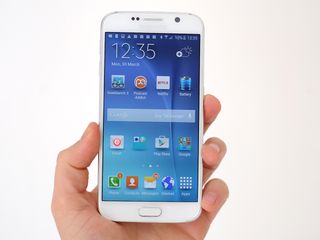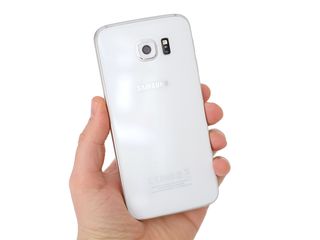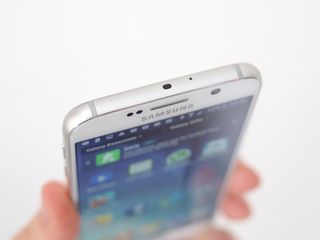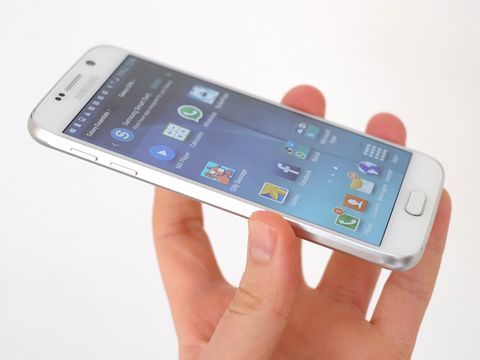IT Pro Verdict
Samsung sets the bar for 2015 with a phone that solves many long-standing issues with Samsung phones.
Pros
- +
Superb screen; High-quality construction and feel; Efficient and powerful processor; Very good fingerprint scanner
Cons
- -
Non-expandable storage; Fixed battery
UPDATE: The Samsung S7 has now been launched. See out S7 news hub, S7 hands-on and how itcompares withthe S6.
If you've got one of Samsung's flagship handsets winging its way to you this holiday season, check out our handy tips and tricks on how to get the best out of your new Galaxy S6.
Read reports on Samsung's mobile profits and it can seem like the company is on the slide. An incredibly successful company on the slide, granted, but one that has seen better days nevertheless.
The Samsung Galaxy S6 has a lot to prove, and an awful lot of boxes to shift. However, it truly deserves to. It makes significant, meaningful improvements in many areas of last year's Samsung Galaxy S5, and is a far cry from the tip-toe iterations of Samsung's previous flagship Android phones.
Samsung Galaxy S6: Latest News
20/03/2017: The Android Nougat update is now rolling out to Samsung Galaxy S6 devices across the globe, but you'll still have to wait a while until the Android 7.1.1 update is added to the standard Nougat build.
The update comes with a whole host of goodies compared to the Android Marshmallow update that was released almost exactly a year ago, including better performnce thanks to the new JIT Compiler, VR mode, the Vulkan API, which offers higher performance graphics and longer battery life with Doze.
Data saver will save your monthly data allowance too, by turning off apps comsuming your allowance when they're not in use. File-based encryption makes it more secure to store your work files on your Samsung Galaxy S6 and on the security front, scoped folder access is an update to the previous app runtime permissions.
The company's Smart Lock feature has also been updated, making it more accurate to unlock a device using facial features. It's called Trusted Face and it's a lot more acurate than the previous iteration, making it easier to unlock your phone even if the lighting conditions or your position are a little off.
15/03/2016:T-Mobile and AT&T in the US are rolling outAndroid Marshmallow for Samsung Galaxy Note 5 and Galaxy S6 from March 15.
This was reported in a customer forum on XDA-developers.
16/02/2016:Marshmallow will be pushed out to users in the UK this February. This comes three months after Nexus users got their update.
In a statement, Samsung said the OS would roll out to S6 and S6 Edge phones."For upgradable models, Samsung will make separate announcements on details of OS updates schedule for each market according to market situation and carriers' requirements," it said.
Samsung Galaxy S6: Build quality and appearance
Where previous Samsung flagships had plastic bodies or, in the case of the Note 4, plastic backs and metal sides, the S6 is made of glass and metal. Samsung seems to have taken a lot of the design cues from both the iPhone 6 and the iPhone 4/4S.
Its back and front use panes of Gorilla Glass 4, the latest version of Corning's ultra-tough glass. It feels a lot tougher and more expensive than plastic, textured or otherwise. There's a valid concern that owners might end up smashing the Galaxy S6's back, but Samsung has done its best on this front by using what is the most suitable glass readily available.
Even if Sapphire crystal was not prohibitively expensive for this role and it is its additional hardness actually makes it more shatter-prone than Gorilla Glass 4. The glass panels are joined by aluminium sides which have been contoured for comfort. In terms of feeling like a phone worth its asking price, the Samsung Galaxy S6 is a huge step up over the Galaxy S5.
Samsung Galaxy S6: storage and fingerprint reader
After the best part of a decade making Android phones, Samsung is finally acknowledging that a phone feeling expensive has its own value, shallow as it may be. This is a very Apple-like sentiment, and unfortunately that Apple approach has bled into the approach to storage.
The Samsung Galaxy S6 does not have an SD card slot. Instead, there is a wider choice of built-in storage capacities - 32GB, 64GB and 128GB versions with a 80 price jump between each tier. If you find you need more storage than you have built-in, then your only recourse is to either use online storage or to delete or move extraneous files to your PC. By making storage non-expandable, Samsung can capitalise on the greater margins of the higher-storage versions at the risk of losing some customers.

In other areas, the Galaxy S6 is undoubtedly better compared to its predecessor most notably its massively improved fingerprint scanner. With the S5 (as well as other Galaxy devices such as the Note 4), you had to swipe your finger very slowly and precisely over the fingerprint reader built into the Home button. It was therefore much more frustrating to use than the Touch ID fingerprint readers built into iPhones, often requiring repeated swipes.
In this new model, the hardware is different, while still living under the Home button. Now, a digit only needs to be placed on the sensor, not swiped across it. Accuracy and reliability have improved immensely, making it a great way to quickly unlock the phone.
Samsung Galaxy S6: Knox security
Some of Samsung's Knox security software has now been built into Android 5.0 Lollipop, which is pre-installed on the S6. Android for Work is Google's name for this subset of Knox. It's more than just the ability to keep your work and personal apps and data separate, though it's the basis for Google's own MDM service as our separate review details.
Samsung has kept some Knox features for its own phones, such as the ability for IT managers to prevent users from using unauthorised boot loaders on their S6, VPN settings customised on an app-by-app basis and federated logins.
For consumers with simpler security needs, the Private mode will be of interest. It locks selected files, including pictures and videos behind a security measure of choice. This can be the same fingerprint used for the lock screen or a separate password.
Samsung Galaxy S6: Screen
What it also does better than rivals is screen quality. Like other Galaxy S phones, the S6 has a Super AMOLED display. This one is 5.1 inches across and has a resolution of 2560 x 1440 pixels (also called QHD).
Its high pixel density of 577ppi means text is very sharp. Black levels are immaculate and, with the right setting, colours are excellent. The Galaxy S6 has several screen quality modes, although some can make colours look washed out while others make colours look oversaturated.

There's still some work to be done here in reducing the effect of reflections, but this is a wider issue for phone development in general. Otherwise, it's a phenomenal display.
Samsung Galaxy S6: Software
Samsung still insists on including its own TouchWiz interface on top of Android 5.0 Lollipop, but it's far less intrusive and annoying compared to previous versions on older Galaxy phones.
It's less cluttered with fewer extraneous dialogue boxes and far fewer needless pre-installed apps. Much of Samsung's older TouchWiz-specific animations and appearance have been thankfully superceded by those native to Google's Material Design. It's a very welcome change.
Samsung Galaxy S6: Performance
Unlike some older Samsung phones, the Galaxy S6's performance is also very good from day one. In the past, its devices have been prone to significant lag that had to be fixed with post-release performance updates, but speed is great here.
While phone processor power is becoming largely academic for most users' needs, this phone's processor performance was still nonetheless impressive. Rather than using a Qualcomm Snapdragon processor like the UK variant of the Galaxy S5, all current versions of the Galaxy S6 use Samsung's Exynos 7420 processor.
This is an eight-core CPU with four power cores clocked at 2.1GHz and four efficiency cores at 1.5GHz. This is fairly similar to the Qualcomm Snapdragon 810, but the chipset is manufactured using a 14nm process, allowing for greater efficiency than the 20nm Qualcomm.

It's no surprise, then, that it benchmarked very well and is more than capable of running almost any demanding app you can throw at it. The difference in performance between the Exynos 7420 and the Snapdragon 810 in other Android phones is small though and won't be noticeable in everyday use.
Stress-testing the Galaxy S6, we found it capable of managing excess heat. The phone gets warm but only gets to near-hot level when the phone is being charged. It does seem that Samsung has been quite careful in its throttling of the CPU to guarantee this low-heat result, though.
There is a peak processor performance drop of around 10 per cent after punishing the Galaxy S6 for a while, somewhat similar to the in theory less efficient Snapdragon 810. But then Snapdragon 810 phones to date have had more of an issue with overheating.
Samsung Galaxy S6: Battery Life
The Samsung Galaxy S6 no longer has a user replaceable battery, unlike older Galaxy S phones. This would be fine, except its battery life when playing H.264 videos wasn't as lengthy as the S5. It lasted 13 hours and 40 minutes compared to the S5's 17 hours and 18 minutes.
In general everyday use, when connected to Vodafone's 4G network in central London, the battery still managed to last a full working day but we had to make greater use of Samsung's power-saving modes than we did with the S5. As with the last lead Samsung phone, there are two main battery-saver modes: a standard one that limits screen brightness and CPU power just a little, and an ultra mode that takes more drastic action by effectively turning the S6 into a black and white feature phone by limiting you to just phone calls and texts.
While the lack of an easily removable battery will be off-putting to many, the Galaxy S6 does have a fast-charge ability. Charging the battery from empty for just ten minutes using the included charger was enough to give four hours of H.264 video playback.

The phone also supports both of the current wireless' inductive charging standards, Qi and PowerMat. Although Samsung sells its wireless charging pad comes separately, this extensive compatibility means it'll work with most existing third-party wireless charging pads including ones from Nokia and Sony.
Samsung Galaxy S6: Camera
One of the biggest areas of improvement is in the S6's camera. While it appears to use the same sensor as the Galaxy Note 4, software improvements and the use of a faster f/1.9 lens see improved results across the board.
First, the Samsung Galaxy S6 camera is very fast. Shot-to-shot speeds are excellent, regardless of whether standard shots or HDR photos are captured. Even in low-light conditions, the phone remains very quick. The only issue is endemic to its contrast detection focusing. Trying to focus on a low-contrast object in indoors lighting can leave the phone seeking for a lock-on without success. The same can be said of just about all phones, though.
Image quality is very consistent too, with excellent dynamic range and colour accuracy with little noise, especially when used with the software-optimised HDR Auto' mode. Much like the iPhone 6, it offers great image quality with little-to-no camera expertise.
On the front sits a 5-megapixel camera. It is solid, but ultimately more ordinary than the rear one. Quality hasn't made a huge jump from last year's 3.7-megapixel front-facing camera.
Samsung Galaxy S6: Is it worth it?
In a market where lower-cost phones are starting to offer an experience similar to much more expensive ones, something special is needed to justify the S6's high price especially as it does away with features that have helped Samsung set itself apart from the competition such as an SD slot, removable battery and oodles of own-branded software.

Samsung has hit the mark, though. A great fingerprint scanner, construction that is leagues ahead of any previous Samsung flagship and a very reliable, high-quality camera make it a very compelling phone. Only its battery life could be better, regressing from the S5's exemplary scores, but the S6 is still far better value than the S6 Edge, its overpriced, showy sibling.
This review was published on 31/03/15. It was last updated on 15/03/2016.
Samsung Galaxy S6:
Verdict
Samsung sets the bar for 2015 with a phone that solves many long-standing issues with Samsung phones.
Processor: Exynos 7420 2.1GHz
GPU: Mali-T760
Memory: 3GB RAM
Storage: 32GB/64GB/128GB on-board, non-expandable
Connectivity: 802.11ac Wi-Fi, Bluetooth 4.0, 4G, IR
Ports: MicroUSB 2.0, headphone jack, nano SIM
Dimensions: (WxDxH): 143.4 x 70.5 x 6.8
Weight: 138g


